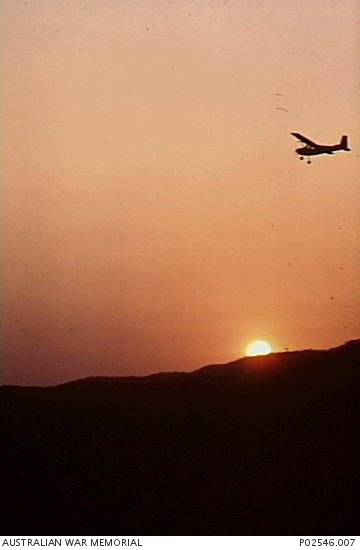Possums on patrol: 161 Independent Reconnaissance Flight during the Vietnam War
The Possums in front of one of their planes used for reconnaissance missions, Vung Tau Special Zone, Vietnam, c 1965-75. Photograph by Denis Stanley Gibbons. P04669.186
In 1965, an army aviation unit, comprising small fixed-wing planes and various models of helicopters, was raised to support operations in the Vietnam War. From 1965 to 1972, 161 Independent Reconnaissance Flight (161 IRF), call sign Possums, proved to be a highly versatile unit working out of bases in Vietnam. Its work included routine daily reconnaissance flights, transferring casualties to a hospital, civilian support, and electronic surveillance, undertaking repairs, and working with other units.
After arriving in Vietnam in 1965, the Possums were stationed at the Bien Hoa base, sharing space with American units for some months. When their parent unit became 1 Australian Task Force (1ATF), comprising two battalions and support units, the Possums moved to their base in the Vung Tau Special Zone. During 1965 and 1966, a major new airfield, Luscombe Field, was built at Nui Dat; this became the Possums’ base for the rest of their time in Vietnam.
Possums at the new Luscombe Field base: under construction in 1965-1966, Vung Tau Special Zone, Vietnam. Photograph by Denis Stanley Gibbons. P04668.015
The Possums’ daily first- and last-light patrols were essential for gathering up-to-date information about enemy actions on the ground, and relaying it to Australian and American units involved in organising air-strikes. Working as Forward Air Controllers (FACs), 161’s patrol crews also marked spots of activity for strikes. This FAC work often involved using phosphorescent flares, which greatly increased risks of detection and attack.
One of the Possums’ Cessnas during an observation flight at sunset, c. October 1968–March 1969. The Cessnas were replaced with Porter Pilatus fixed-wing planes in 1969. Photograph by Stephen Lewis. P02546.007
Signaller Robert Vallance, on detachment from 104 Signals Squadron, discovered how a surveillance flight could become an evacuation case. On 19 February 1969, he joined a Visual Reconnaissance flight in cooperation with a US Air Force (USAF) plane. Weather conditions reduced visibility to 50 per cent, and the American pilot lost sight of the Possums’ Sioux helicopter near a clearing. The Possum pilot unsuccessfully attempted evasive action against anti-aircraft fire. The Sioux was hit, and crashed. The pilot and Signaller Vallance were injured, but survived. They escaped, retrieved some gear, and signalled to the USAF plane for help.
One of 161’s Sioux helicopters, replaced by larger Kiowa helicopters in 1970-71. Photograph by Denis Stanley Gibbons. P04666.996
A nearby RAAF helicopter took both men to a hospital for examination and treatment. After an investigation, the Sioux was written off as irreparable.
The demand for Possums’ support work grew throughout the war, helped by their reputation for being highly skilled and adaptable. The unit’s mix of small planes and helicopters proved useful for reaching a wide range of communities in remote locations. For psychological warfare, small fixed-wing planes could be fitted with a public-address system to broadcast recorded “surrender!” messages. For civilian aid work (known as “winning hearts and minds”), Possums could travel to communities to distribute medical supplies, or visit orphans in a convent. Occasionally, the Possums escorted student groups to the beach at Vung Tau. These experiences were remembered by students and teachers for decades, and gave the Possums a welcome change from routine work.
One of the Possums (right-hand side of frame) with Vietnamese civilians during a civilian-support visit, Xuyen Moc, Phuoc Tuy Province, 1967. Photograph by Denis Stanley Gibbons. P04669.106
By 1972 there was a substantial reduction in work for the Possums and the unit was recalled to Australia. Some of the unit’s helicopters and planes were shipped home on HMAS Sydney. The Kiowa helicopters, leased from the US Army, were returned to American contacts as part of the Possums’ homeward trips.

Page from the unit’s war diary, showing return of aircraft to US Army as part of the Possums’ return to Australia in 1972. RCDIG1029757
On return to Australia, there was minimal formal de-briefing for personnel. Any unit members not going on to another deployment were expected to go home and fit into a new life.
The Possums proved to be a skilled, versatile, and highly resilient unit. Its members worked well on their own and cooperatively with other units in Vietnam. One particular American unit, 3/17 Air Cav, known as Silver Spurs, formed a high regard for the Possums after some Spurs undertook pilot training with them. There were very few fatalities, considering the range of duties and operations in very dangerous front-line areas. In 1991, the unit received a United States Army Meritorious Unit Citation.
At reunions and in histories written since the end of the war, 161 Independent Reconnaissance Flight has become an inspirational unit. Those who served as Possums had and have many reasons to be proud of their record.
View 161 IRF's unit war diaries and various specific mission records.




